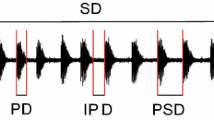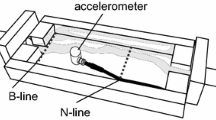Abstract
An element common to the recruitment communication of eusocial bees (honey bees, stingless bees and bumble bees) are pulsed thorax vibrations generated by successful foragers within the nest. In stingless bees, foragers vibrate during the unloading of the collected food. In the present study on Melipona seminigra we demonstrate that during trophallactic contacts, the food receivers are directly vibrated by the foragers. As a consequence, both the temporal structure and the main frequency component of the forager’s vibrations are directly passed on to the receiver. The vibrations are attenuated by about 17 dB on their way from the forager’s thorax (velocity amplitude of the vibrations: ∼70 mm/s) to the receiver’s thorax (∼10 mm/s), the main amount of attenuation (about 12 dB) occurring during transmission from the head of the forager to that of the receiver. Vibrations conducted through the substrate between the forager and food receiver are comparatively small with velocity amplitudes of 0.3 mm/s. Possible ways of perception and the advantages of vibration transmission by direct contact within the recruitment context are discussed.









Similar content being viewed by others
References
Aguilar I, Briceño D (2002) Sounds in Melipona costaricensis (Apidae: Meliponini): effect of sugar concentration and nectar source distance. Apidologie 33:375–388
Autrum H, Schneider W (1948) Vergleichende Untersuchungen über den Erschütterungssinn der Insekten. Z vergl Physiol 31:77–88
Biesmeijer JC, van Nieuwstadt MGL, Lukács S, Sommeijer MJ (1998) The role of internal and external information in foraging decisions of Melipona workers (Hymenoptera: Meliponinae). Behav Ecol Sociobiol 42:107–116
Dyer FC (2002) The biology of the dance language. Annu Rev Entomol 47:917–949
Esch H (1967) Die Bedeutung der Lauterzeugung für die Verständigung der stachellosen Bienen. Z vergl Physiol 56:199–220
Farina WM (1996) Food exchange by foragers in the hive–a means of communication among honey bees? Behav Ecol Sociobiol 38:59–64
Farina WM, Núñez JA (1991) Trophallaxis in the honeybee, Apis mellifera (L.) as related to the profitability of food sources. Anim Behav 42:389–394
Gil M, Farina WM (2003) Crop scents affect the occurrence of trophallaxis among forager honeybees. J Comp Physiol A 189:379–382
Goyret J, Farina WM (2003) Descriptive study of antennation during trophallactic contacts in honeybees Apis mellifera carnica. Insects Soc 50:274–276
Hart Q, Ratnieks FLW (2001) Why do honeybee nectar foragers transfer nectar to several receivers? Information improvement through multiple transfer in a biological system. Behav Ecol Sociobiol 49:244–251
Hart A, Ratnieks FLW (2002) Task-partitioned nectar transfer in stingless bees: work organisaion in a phylogenetic context. Ecol Entomol 27:163–168
Heran H (1959) Wahrnehmung zur Regelung der Flugeigengeschwindigkeit bei Apis mellifica L. Z vergl Physiol 42:103–163
Hrncir M (2003) Properties and significance of recruitment signals in a stingless bee (Melipona seminigra Friese 1903). Doctoral thesis. University of Vienna, Austria
Hrncir M, Jarau S, Zucchi R, Barth FG (2000) Recruitment behavior in stingless bees, Melipona scutellaris and M. quadrifasciata. II. Possible mechanisms of communication. Apidologie 31:93–113
Hrncir M, Jarau S, Zucchi R, Barth FG (2004a) Thorax vibrations in stingless bees (Melipona seminigra). I. No influence of visual flow. J Comp Physiol A 190:539–548
Hrncir M, Jarau S, Zucchi R, Barth FG (2004b) Thorax vibrations in stingless bees (Melipona seminigra). II. Dependence on sugar concentration. J Comp Physiol A 190:549–560
Hrncir M, Barth FG, Tautz J (2006) Vibratory and airborne-sound signals in bee communication (Hymenoptera). In: Drosopoulos S, Claridge M (eds) Insect sounds and communication: physiology, behaviour and evolution. CRC Press, Taylor & Francis Group, Boca Raton London New York, pp 421–436
Kilpinen O, Storm J (1997) Biophysics of the subgenual organ of the honeybee, Apis mellifera. J Comp Physiol A 181:309–318
Kirchner WH (1997) Acoustical communication in social insects. In: Lehrer M (ed) Orientation and communication in arthropods. Birkhäuser Verlag, Basel Switzerland, pp 273–300
Korst PJAM, Velthuis HHW (1982) The nature of trophallaxis in honeybees. Insect Soc 29:209–221
Kronberger E (2000) Futterplatzrekrutierung bei Melipona seminigra merillae. Diploma thesis. University of Vienna, Austria
Lindauer M, Kerr WE (1958) Die gegenseitige Verständigung bei den stachellosen Bienen. Z vergl Physiol 41:405–434
de Marco RJ, Farina WM (2003) Trophallaxis in forager honeybees (Apis mellifera): resource uncertainty enhances begging contacts? J Comp Physiol A 189:125–134
McIndoo NE (1922) The auditory sense of the honey-bee. J Comp Neurol 34:173–199
Michelsen A (2003) Signals and flexibility in the dance communication of honeybees. J Comp Physiol A 189:165–174
Nieh JC, Roubik DW (1998) Potential mechanisms for the communication of height and distance by a stingless bee, Melipona panamica. Behav Ecol Sociobiol 43:387–399
Nieh JC, Contrera FAL, Rangel J, Imperatriz-Fonseca VL (2003) Effect of food location and quality on recruitment sounds and success in two stingless bees, Melipona mandacaia and Melipona bicolor. Behav Ecol Sociobiol 55:87–94
Rohrseitz K, Kilpinen O (1997) Vibration transmission characteristics of the legs of freely standing honeybees. Zoology 100:80–84
Sandeman DC, Tautz J, Lindauer M (1996) Transmission of vibration across honeycombs and its detection by bee leg receptors. J Exp Biol 199:2585–2594
Schön A (1911) Bau und Entwicklung des tibialen Chordotonalorgans bei der Honigbiene und bei Ameisen. Zool Jb Anat 31:439–472
Snodgrass RE (1956) Anatomy of the honey bee. Cornell University Press, Ithaca New York
Tautz J (1996) Honey bee waggle dance: recruitment success depends on the dance floor. J Exp Biol 199:1375–1381
Tautz J, Rohrseitz K (1998) What attracts honeybees to a waggle dancer? J Comp Physiol A 183:661–667
Wilson EO (1971) The insect societies. Harvard University Press, Cambridge
Acknowledgements
We thank Sidnei Mateus for his help with the bees, and Walter Farina (University of Buenos Aires) for valuable comments on the trophallaxis of honey bees. The experiments comply with the current laws of Brazil, where they were carried out. This study was supported by grant P17530 of the Austrian Science Fund to FGB
Author information
Authors and Affiliations
Corresponding author
Rights and permissions
About this article
Cite this article
Hrncir, M., Schmidt, V.M., Schorkopf, D.L.P. et al. Vibrating the food receivers: a direct way of signal transmission in stingless bees (Melipona seminigra). J Comp Physiol A 192, 879–887 (2006). https://doi.org/10.1007/s00359-006-0123-8
Received:
Revised:
Accepted:
Published:
Issue Date:
DOI: https://doi.org/10.1007/s00359-006-0123-8




